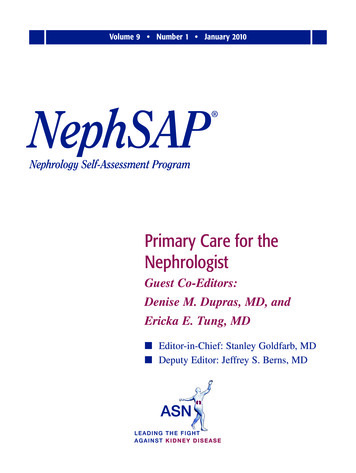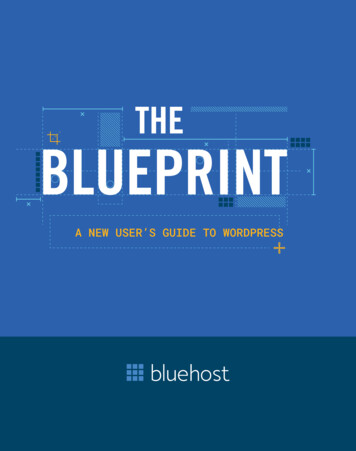
Transcription
Volume 9 Number 1 January 2010NephSAP Nephrology Self-Assessment ProgramPrimary Care for theNephrologistGuest Co-Editors:Denise M. Dupras, MD, andEricka E. Tung, MD Editor-in-Chief: Stanley Goldfarb, MD Deputy Editor: Jeffrey S. Berns, MD
NephSAPEDITOR-IN-CHIEFStanley Goldfarb, MDUniversity of Pennsylvania Medical SchoolPhiladelphia, PADEPUTY EDITORJeffrey S. Berns, MDUniversity of Pennsylvania Medical SchoolPhiladelphia, PAMANAGING EDITORGisela Deuter, BSN, MSAWashington, DCASSOCIATE EDITORSRajiv Agarwal, MDIndiana University School of MedicineIndianapolis, INDavid J. Cohen, MDColumbia UniversityNew York, NYSteven Fishbane, MDStony Brook School of MedicineMinneola, NYRichard J. Glassock, MDProfessor Emeritus, The David Geffen Schoolof Medicine at the University of CaliforniaLos Angeles, CAKevin J. Martin, MBBChSt. Louis University School of MedicineSt. Louis, MORajnish Mehrotra, MDHarbor UCLA Research and Education InstituteTorrance, CA PrefaceNephSAP is one of the three major publications of the American Society of Nephrology(ASN). Its primary goals are self-assessment, education, and the provision of ContinuingMedical Education (CME) credits and Maintenance of Certification (MOC) credits forindividuals certified by the American Board of Internal Medicine. Members of the ASNautomatically receive NephSAP with their monthly issue of The Journal of the AmericanSociety of Nephrology (JASN).EDUCATION: Medical and Nephrologic information continually accrues at a rapid pace.Bombarded from all sides with demands on their time, busy practitioners, academicians,and trainees at all levels are increasingly challenged to review and understand all this newmaterial.Each bimonthly issue of NephSAP is dedicated to a specific theme, i.e., to a specificarea of clinical nephrology, hypertension, dialysis, and transplantation, and consists of anEditorial, a Syllabus, a Commentary on the Syllabus, and self-assessment questions. Overthe course of 24 months, all clinically relevant and key elements of nephrology will bereviewed and updated. The authors of each issue digest, assimilate, and interpret keypublications from the previous issues of other years and integrate this new material with thebody of existing information.SELF-ASSESSMENT: Twenty-five single-best-answer questions will follow the 50 to 75 pagesof Syllabus text. The examination is available online with immediate feedback. Those answering 75% correctly will receive CME credit, and receive the answers to all the questions alongwith brief discussions and an updated bibliography. To help answer the questions, readers maygo to the ASN web site, where relevant material from UpToDate in nephrology will be posted.Thus, members will find a new area reviewed every 2 months, and they will be able to test theirunderstanding with our quiz. This format will help readers stay abreast of developing areas ofclinical nephrology, hypertension, dialysis, and transplantation, and the review and update willsupport those taking certification and recertification examinations.Patrick T. Murray, MDUniversity College DublinDublin, IrelandPatrick H. Nachman, MDUniversity of North CarolinaChapel Hill, NCPaul M. Palevsky, MDUniversity of Pittsburgh School of MedicinePittsburgh, PACONTINUING MEDICAL EDUCATION: Most state and local medical agencies as well ashospitals are demanding documentation of requisite CME credits for licensure and for staffappointments. A maximum of 36 credits annually can be obtained by successfully completingthe NephSAP examination. In addition, individuals certified by the American Board of InternalMedicine may obtain credits towards Maintenance of Certification (MOC) by successfullycompleting the self-assessment portion of NephSAP.Richard H. Sterns, MDBOARD CERTIFICATION AND INSERVICE EXAMINATION PREPARATION: Each issuewill also contain 5 questions and answers examining core topics in the particular disciplinereviewed in the Syllabus. These questions are designed to provide trainees with challengingquestions to test their knowledge of key areas of nephrology.University of Rochester School of Medicineand DentistryRochester, NY This paper meets the requirements of ANSI/NISO Z39.48-1921 (Permanence of Paper),effective with July 2002, Vol. 1, No. 1.Biff F. Palmer, MDUniversity of Texas Southwestern Medical CenterDallas, TXStephen C. Textor, MDMayo ClinicRochester, MNRaymond R. Townsend, MDUniversity of Pennsylvania Medical SchoolPhiladelphia, PAJohn P. Vella, MDMaine Medical CenterPortland, MEFOUNDING EDITORSGUEST EDITORSRichard J. Glassock, MD, MACPEditor-in-Chief EmeritusRobert G. Narins, MD, MACPDenise M. Dupras, MDMayo Clinic College of MedicineRochester, MNEricka E. Tung, MDMayo Clinic College of MedicineRochester, MNNephSAP 2010 by The American Society of Nephrology
NephSAP Volume 9, Number 1, January 2010Primary Care for the NephrologistEditorial1The Nephrology–Primary Care Interface: Providing CoordinatedCare for Chronic Kidney Disease—Thomas D. DuBose, Jr.,MD, Mary Tessie Behrens, MD, Arnold Berns, MD, PaulKlotman, MD, Jerry Yee, MD, and Ruth C. Campbell, MDEditorial5Beyond the Kidneys: The Nephrologist’s Responsibilities as anInternal Medicine Specialist—Steven Weinberger, MDSyllabus8Primary Care for the Nephrologist—Denise M. Dupras, MD,PhD, and Ericka E. Tung, MD, MPHDefining Primary Care . . . . . . . . . . . . . . . . . . . . . . . . . . . . . . .8Screening for Disease . . . . . . . . . . . . . . . . . . . . . . . . . . . . . . . .9Understanding Guidelines . . . . . . . . . . . . . . . . . . . . . . . . . . . . .9Cancer . . . . . . . . . . . . . . . . . . . . . . . . . . . . . . . . . . . . . . . . . . .11Burden of Disease . . . . . . . . . . . . . . . . . . . . . . . . . . . . . . . .11Principles of Prevention and Cancer Screening for OlderAdults . . . . . . . . . . . . . . . . . . . . . . . . . . . . . . . . . . . . . . . .11Cancer Screening in Chronic Kidney Disease . . . . . . . . . .12Lung Cancer . . . . . . . . . . . . . . . . . . . . . . . . . . . . . . . . . . . .13Burden of Disease. . . . . . . . . . . . . . . . . . . . . . . . . . . . . . .13Screening Recommendations . . . . . . . . . . . . . . . . . . . . . .13Breast Cancer . . . . . . . . . . . . . . . . . . . . . . . . . . . . . . . . . . . .13Burden of Disease. . . . . . . . . . . . . . . . . . . . . . . . . . . . . . .13Screening Recommendations . . . . . . . . . . . . . . . . . . . . . .13
NephSAP Volume 9, Number 1, January 2010Colon Cancer . . . . . . . . . . . . . . . . . . . . . . . . . . . . . . . . . . . .15Burden of Disease. . . . . . . . . . . . . . . . . . . . . . . . . . . . . . .15Screening Recommendations . . . . . . . . . . . . . . . . . . . . . .15Surveillance after Polypectomy Recommendations. . . . .18Prostate Cancer . . . . . . . . . . . . . . . . . . . . . . . . . . . . . . . . . .18Burden of Disease. . . . . . . . . . . . . . . . . . . . . . . . . . . . . . .18Screening Recommendations . . . . . . . . . . . . . . . . . . . . . .18Cervical Cancer . . . . . . . . . . . . . . . . . . . . . . . . . . . . . . . . . .19Burden of Disease. . . . . . . . . . . . . . . . . . . . . . . . . . . . . . .19Preventing Cervical Cancer . . . . . . . . . . . . . . . . . . . . . . .19Screening Recommendations . . . . . . . . . . . . . . . . . . . . . .20Skin Cancer . . . . . . . . . . . . . . . . . . . . . . . . . . . . . . . . . . . . .20Thyroid Disease . . . . . . . . . . . . . . . . . . . . . . . . . . . . . . . . . . . .23Burden of Disease . . . . . . . . . . . . . . . . . . . . . . . . . . . . . . . .23Screening Recommendations . . . . . . . . . . . . . . . . . . . . . . .24Hyperlipidemia . . . . . . . . . . . . . . . . . . . . . . . . . . . . . . . . . . . .24Background . . . . . . . . . . . . . . . . . . . . . . . . . . . . . . . . . . . . .24Screening Recommendations . . . . . . . . . . . . . . . . . . . . . . .25Abdominal Aortic Aneurysm Screening Recommendations . . .26Burden of Disease . . . . . . . . . . . . . . . . . . . . . . . . . . . . . . . .26Screening Recommendations . . . . . . . . . . . . . . . . . . . . . . .27Screening for Type 2 Diabetes . . . . . . . . . . . . . . . . . . . . . . . .28Definition and Burden of Disease . . . . . . . . . . . . . . . . . . .28Screening Recommendations . . . . . . . . . . . . . . . . . . . . . . .29Depression . . . . . . . . . . . . . . . . . . . . . . . . . . . . . . . . . . . . . . . .29Burden of Disease . . . . . . . . . . . . . . . . . . . . . . . . . . . . . . . .29Screening Recommendations . . . . . . . . . . . . . . . . . . . . . . .30
NephSAP Volume 9, Number 1, January 2010Obesity . . . . . . . . . . . . . . . . . . . . . . . . . . . . . . . . . . . . . . . . . . .31Burden of Disease . . . . . . . . . . . . . . . . . . . . . . . . . . . . . . . .31Screening Recommendations . . . . . . . . . . . . . . . . . . . . . . .31Treatment Guidelines . . . . . . . . . . . . . . . . . . . . . . . . . . . . .32Smoking . . . . . . . . . . . . . . . . . . . . . . . . . . . . . . . . . . . . . . . . . .34Background . . . . . . . . . . . . . . . . . . . . . . . . . . . . . . . . . . . . .34Screening Recommendations . . . . . . . . . . . . . . . . . . . . . . .34Treatment Recommendations . . . . . . . . . . . . . . . . . . . . . . .34Falls: Assessment and Prevention . . . . . . . . . . . . . . . . . . . . . .35Scope of Problem . . . . . . . . . . . . . . . . . . . . . . . . . . . . . . . .35Assessment . . . . . . . . . . . . . . . . . . . . . . . . . . . . . . . . . . . . . .36Interventions . . . . . . . . . . . . . . . . . . . . . . . . . . . . . . . . . . . .36Multifactorial Risk Reduction Strategy . . . . . . . . . . . . . .36Vitamin D Supplementation . . . . . . . . . . . . . . . . . . . . . . .38Medication Optimization . . . . . . . . . . . . . . . . . . . . . . . . .38Exercise . . . . . . . . . . . . . . . . . . . . . . . . . . . . . . . . . . . . . . .38Conclusions . . . . . . . . . . . . . . . . . . . . . . . . . . . . . . . . . . . . .38Dementia . . . . . . . . . . . . . . . . . . . . . . . . . . . . . . . . . . . . . . . . .40Scope of Syndrome . . . . . . . . . . . . . . . . . . . . . . . . . . . . . . .40Recognition of the Syndrome and Screening . . . . . . . . . . .41Treatment . . . . . . . . . . . . . . . . . . . . . . . . . . . . . . . . . . . . . . .41Cholinesterase Inhibitors . . . . . . . . . . . . . . . . . . . . . . . . .42Memantine. . . . . . . . . . . . . . . . . . . . . . . . . . . . . . . . . . . . .42Nonpharmacologic Interventions . . . . . . . . . . . . . . . . . . .42Summary Recommendations for Treatment of Dementia . . .42Behavioral Problems in Dementia . . . . . . . . . . . . . . . . . . .43Pharmacologic and Nonpharmacologic Interventions forBehavioral Disturbance . . . . . . . . . . . . . . . . . . . . . . . . . .43Immunizations . . . . . . . . . . . . . . . . . . . . . . . . . . . . . . . . . . . . .45
NephSAP Volume 9, Number 1, January 2010CME Self-Assessment Questions . . . . . . . . . . . . . . . . . . . . . 46Questions Linked to UpToDate in GreenUpcoming IssuesHypertension—Stephen C. Textor, MD, and Raymond R. Townsend, MD . .March 2010Glomerular, Tubulointerstitial, and Vascular Diseases—Richard J. Glassock, MD, and Patrick Nachman, MD . . . . . . .May 2010Clinical Pharmacology—Suzanne Swan, MD, Ali J. Olyaei, Pharm D, BCPS,and Dominic Sica, MD . . . . . . . . . . . . . . . . . . . . . . . . . . .July 2010Renal Bone Disease, Disorders of Divalent Ions, andNephrolithiasis—Kevin Martin, MBBCh, and Stanley Goldfarb, MD . . . .September 2010End-Stage Renal Disease and Dialysis—Rajiv Agarwal, MD, and Rajnish Mehrotra, MD . . . . .November 2010
NephSAP Volume 9, Number 1, January 2010The Editorial Board of NephSAP extends its sincere appreciation to the following reviewers. Their efforts and insights have helped toimprove the quality of this postgraduate education offering.NephSAP Review PanelNihal Y. Abosaif, MBBChSt. James University HospitalLeeds, United KingdomSusan R. DiGiovanni, MDVirginia Commonwealth UniversityRichmond, VAQuresh T. Khairullah, MD, FASNSt. Clair Specialty PhysiciansDetroit, MIGeorgi Abraham, MBBSSri Ramachandra UniversityMedical CenterChennai, IndiaFrancis Dumler, MDWilliam Beaumont HospitalRoyal Oak, MIApurv Khanna, MDSUNY Upstate Medical UniversitySyracuse, NYMahmoud T. El-Khatib, MD, PhD, FASNUniversity of Cincinnati Medical CenterCincinnati, OHRamesh Khanna, MDUniversity of Missouri at ColumbiaSchool of MedicineColumbia, MOPablo H. Abrego, MD, FASNMarshfield ClinicWausau, WIAnil K. Agarwal, MD, FASNOhio State University Medical CenterColumbus, OHMustafa Ahmad, MDKing Fahad Medical CityRiyadh, Saudi ArabiaJafar Al-Said, MD, FASNBahrain Specialist HospitalManama, BahrainDante Amato-Martinez, MD, PhDUniversidad Nacional Autónoma de MéxicoTlalnepantla, MexicoAnis U. Ansari, MDMedical AssociatesClinton, IAAkhtar Ashfaq, MD, FASNNorth Shore University HospitalGreat Neck, NYAzra Bihorac, MD, FASNUniversity of FloridaGainesville, FLMona B. Brake, MDRobert J. Dole VA Medical CenterWichita, KSMauro Braun, MDCleveland Clinic FloridaWeston, FLLynda A. Frassetto, MD, FASNUniversity of California at San FranciscoSan Francisco, CADuvuru Geetha, MDJohns Hopkins UniversityBaltimore, MDCarl S. Goldstein, MDRobert Wood Johnson Medical SchoolNew Brunswick, NJNabil G. Guirguis, MDKidney Dialysis and Transplant GroupBridgeport, WVPawan K. Gupta, MDAltoona Regional Health SystemAltoona, PACarsten Hafer, MDUniversity of HannoverHannover, GermanyRichard N. Hellman, MDIndiana University School of MedicineIndianapolis, INEkambaram M. Ilamathi, MD, FASNSuffolk Nephrology ConsultantsStony Brook, NYViswanathan S. Iyer, MD, FASNAKD-HTN LLCHarrisburg, PAChokchai Chareandee, MD, FASNRegions HospitalSaint Paul, MNBernard G. Jaar, MDJohns Hopkins Medical Institutions andNephrology Center of MarylandBaltimore, MDDevasmita Choudhury, MDUniversity of Texas SouthwesternMedical SchoolDallas, TXAvanelle V. Jack, MDLouisiana State University HealthSciences CenterNew Orleans, LABulent Cuhaci, MD, FASNDrexel University College of MedicinePhiladelphia, PASharon L. Karp, MDIndiana University School of MedicineIndianapolis, INRajiv Dhamija, MDWalk in Medical CareArtesia, CAPranay Kathuria, MD, FASNUniversity of Oklahoma College of MedicineTulsa, OKEdgar V. Lerma, MD, FASNUniversity of Illinois at ChicagoCollege of MedicineChicago, ILMeyer D. Lifschitz, MDShaare Zedek Medical CenterJerusalem, IsraelPhilippe S. Madhoun, MDChu CharleroiCharleroi, BelgiumJolanta Malyszko, MD, PhD, FASNMedical UniversityBialystok, PolandNaveed N. Masani, MDWinthrop University HospitalMineola, NYHanna W. Mawad, MD, FASNUniversity of Kentucky Medical CenterLexington, KYPascal Meier, MD, FASNCentre Hospitalier Universitaire VaudoisLausanne, SwitzerlandBeckie Michael, DO, FASNMarlton Nephrology and HypertensionMarlton, NJShahriar Moossavi, MD, PhDWake Forest University BaptistMedical CenterWinston-Salem, NCScott R. Mullaney, MDUniversity of California at San DiegoSan Diego, CAQuaid J. Nadri, MD, FASNKing Faisal Specialist Hospital andResearch CenterRiiyadh, Saudi ArabiaSuzanne M. Norby, MD, FASNMayo ClinicRochester, MN
Michal Nowicki, MDMedical University of ŁódźŁódź, PolandPawan K. Rao, MD, FASNSt. Joseph’s Hospital Health CenterSyracuse, NYMacaulay A. Onuigbo, MD, FASNMayo ClinicEau Claire, WIJoel C. Reynolds, MD, FASNBrooke Army Medical CenterSan Antonio, TXThan N. Oo, MDNephrology CenterKalamazoo, MIRobert M.A. Richardson, MDUniversity of TorontoToronto, ON, CanadaKevin P. O’Reilly, MDColumbus Nephrology, Inc.Columbus, OHBijan Roshan, MDJoslin Diabetes CenterHarvard Medical SchoolBoston, MAMalvinder S. Parmar, MB, MS, FASNNorthern Ontario School of MedicineTimmins, ON, CanadaPairach Pintavorn, MD, FASNEast Georgia Kidney and HypertensionAugusta, GAPaul H. Pronovost, MD, FASNYale University School of MedicineWaterbury, CAMohammad A. Quasem, MD, FASNState University of New YorkBinghamton, NYWajeh Y. Qunibi, MDUniversity of Texas Health Sciences CenterSan Antonio, TXVenkat Ramanathan, MD, FASNBaylor College of MedicineHouston, TXKarthik M. Ranganna, MDDrexel University College of MedicinePhiladelphia, PAAbinash C. Roy, MDUniversity of Utah School of MedicineSaint George, UTMario F Rubin, MDMassachusetts General HospitalBoston, MAEhab R. Saad, MD, FASNMedical College of WisconsinMilwaukee, WIMohammad G. Saklayen, MDWright State University Medical SchoolDayton, OHRamesh Saxena, MD, PhDUniversity of Texas SouthwesternMedical CenterDallas, TXGaurang M. Shah, MDLong Beach VA Healthcare SystemLong Beach, CARobert J. Shay, MD, FASNEast Georgia Kidney andHypertension GroupAugusta, GARolf A.K. Stahl, MDUniversity of HamburgHamburg, GermanyHarold M. Szerlip, MD, FASNMedical College of GeorgiaAugusta, GABekir Tanriover, MDDialysis Nephrology AssociatesDallas, TXTushar J. Vachharajani, MD, FASNWake Forest UniversitySchool of MedicineWinston-Salem, NCAllen W. Vander, MD, FASNKidney Center of South LouisianaThibodaux, LALuigi Vernaglione, MDM. Giannuzzi HospitalManduria, ItalyShefali Vyas, MDSaint Barnabas Medical CenterLivingston, NJAlexander Woywodt, MD, FASNLancashire Teaching Hospitals NHSFoundation TrustPreston, United Kingdom
NephSAP Volume 9, Number 1, January 2010Program Mission and ObjectivesThe mission of the Nephrology Self-Assessment Program (NephSAP) is to regularly provide a vehicle that will be useful for clinicalnephrologists who seek to renew and refresh their clinical knowledge and diagnostic and therapeutic skills. This Journal consists of aseries of challenging, clinically oriented questions based on case vignettes, a detailed Syllabus that reviews recent publications,and an Editorial on an important and evolving topic. Taken together, these parts should assist individual clinicians undertaking a rigorous self-assessment of their strengths and weaknesses in the broad domain of nephrology.Accreditation and Credit DesignationThe American Society of Nephrology is accredited by the Accreditation Council for Continuing Medical Education to provide continuing medical education for physicians.The ASN designates this educational activity for a maximum of 8.0 AMA PRA Category 1 Credits . Physicians should only claimcredit commensurate with the extent of their participation in the activity.Continuing Medical Education (CME) InformationCME Credit: 8.0 AMA PRA Category 1 Credits Date of Original Release: January 2010Examination Available Online: on or before Monday, January 11, 2010Audio Files Available: No audio files will be available for this issue.CME Credit Eligible Through: December 31, 2010Answers: Correct answers with explanations will be posted on the ASN website in January 2011 when the issue is archived.UpToDate Links Active: January and February 2010Core Nephrology question links active: There are no core questions for this issue.Target Audience: Nephrology Board and recertification candidates, practicing nephrologists, and internists.Method of Participation: Read the syllabus that is supplemented by original articles in the reference lists, and complete the online self-assessmentexamination. Examinations are available online only after the first week of the publication month. There is no fee. Each participant isallowed two attempts to pass the examination ( 75% correct). Your score and a list of question/s (by number) answered incorrectly can be printed immediately. Your CME certificate can be printed immediately after passing the examination. Answers and explanations are provided ONLY with a passing score on the first or second attempt. Your ASN transcript will be updated in 6 to 8 weeks after passing the examination.Instructions to access the Online CME Center to take the examination and complete the evaluation: Access the ASN website: www.asn-online.org Click on “CME” tab at the top of the homepage and then click on the Online CME Center icon to go to the login page. After login, click on the icon for “NephSAP” Select a topic and click on “Start Now” On the CME Information page, click on “Continue” On the MOC page, select whether or not you want MOC points. On the next page, click on “Examination Questions/Evaluation” to answer the questions. Your score and a list of question numbers answered incorrectly can be printed immediately. Follow the prompts to retake the examination if you failed, or print your certificate and the correct answers if you passed. You can retake the examination at any time. Each participant is allowed two attempts.
NephSAP Volume 9, Number 1, January 2010Instructions to Obtain American Board of Internal Medicine (ABIM) Maintenance of Certification(MOC) Points:Each issue of NephSAP provides 10 MOC points. Respondents must meet the following criteria: Be certified by ABIM in internal medicine and/or nephrology and must be enrolled in the ABIM–MOC programvia the ABIM website (www.abim.org). Pass the self-assessment examination within the timeframe specified in this issue of NephSAP. Designate the issue for MOC points by clicking on the MOC link on the CME certificate page after passing the examination.You will be leaving the ASN-CECity site and transferring the information directly to the ABIM in real-time. Provide your ABIM Certificate ID number and your date of birth. You will receive a confirmation message from the ABIM indicating the receipt of your information.MOC points will be applied to only those ABIM candidates who have enrolled in the program. It is your responsibility to completethe ABIM MOC enrollment process.Instructions to access the ASN website, NephSAP, and the UpToDate linkCompatible Browser: The ASN website (asn-online.org) has been formatted for cross-browser functionality, and shoulddisplay correctly in all modern web browsers. We recommend that you use Internet Explorer.Monitor Settings: The ASN website was designed to be viewed in a 1024 768 or higher resolution.Technical Support: If you are having difficulty viewing any of the pages, please refer to the ASN technical support pagefor possible solutions. If you continue having problems, contact Hal Nesbitt at hnesbitt@asn-online.org.UpToDate provides an additional source of information that should help you answer up to 5 selected NephSAPquestions from each issue. The link is free and will remain active for the first 60 days after publication for eachissue. On the ASN home page, double click on the NephSAP link (NephSAP cover) on the bottom side of the page. On the NephSAP page, click on the UpToDate button on the left hand side to access the current links.
NephSAP Volume 9, Number 1, January 2010Disclosure InformationThe ASN is responsible for identifying and resolving all conflicts of interest prior to presenting any educational activity to learners to ensurethat ASN CME activities promote quality and safety, are effective in improving medical practice, are based on valid contents, and are independent of the control from commercial interests and free of commercial bias. All faculty are instructed to provide balanced, scientificallyrigorous and evidence-based presentations. In accordance with the disclosure policies of the Accreditation Council for Continuing MedicalEducation (ACCME) as well as guidelines of the Food and Drug Administration (FDA), individuals who are in a position to control the content of an educational activity are required to disclose relationships with a commercial interest if (a) the relation is financial and occurredwithin the past 12 months; and (b) the individual had the opportunity to affect the content of continuing medical education with regard to thatcommercial interest. For this purpose, ASN consider the relationships of the person involved in the CME activity to include financial relationships of a spouse or partner. Peer reviewers are asked to abstain from reviewing topics if they have a conflict of interest. Disclosure information is made available to learners prior to the start of any ASN educational activity.Agarwal, Rajiv—Grants/research support: Abbott; Consultant/Scientific advisor: Rockwell Medical, Watson Pharma; Honoraria: Abbott,Astra-Zeneca, MerckBerns, Jeffrey S.—Consultant: Amgen; Research Support: NxStage; Advisory Board: Affymax, NAACCohen, David J.—Grants/research support: Life Cycle Pharma, Novartis, Roche, Wyeth; Honoraria: Bristol-Myers-Squibb, Novartis,RocheFishbane, Steven—Consultant: Abbott, Affymax, AMAG, Genzyme, Watson; Research Support: Affymax, Biogen Idec, Genentech,Takeda; Honoraria: Abbott, Affymax, AMAG, Takeda, Watson; Expert Testimony: Roche; Advisory Board: Affymax, Genzyme,Takeda, WatsonFuchs, Elissa (Medical Editor)—noneGlassock, Richard J.—Consultant: Aspreva, FibroGen, Novartis, Genentech, Keryx, Quest Diagnostics/Nichols Institute, SciencePartners; Honoraria: Visiting professorships at various medical schools; Ownership Interests: LaJolla Pharmaceutical; Paid ExpertTestimony: Various legal firms regarding product reliability; Royalties: Lippincott Williams and Wilkins, Textbook of Nephrology;Scientific Advisor or Membership: American Renal Associates, Aspreva, Los Angeles Biomedical Institute, University KidneyResearch AssociatesGoldfarb, Stanley—Consultant: Lupitold, Omeros; Ownership Interests: Polymedix; Honoraria: GE Healthcare, Fresenius; ExpertTestimony: Bayer; Editorial Board: Journal of Clinical InvestigationMartin, Kevin J.—Grants/research support/honoraria: Abbott; Advisory Board: Abbott, CytochromaMehrotra, Rajnish—Grants/research support: Amgen, Baxter, Shire; Consultant: Novartis; Honoraria: AMAG, Baxter Healthcare,ShireMurray, Patrick T.—Employment: spouse, Merck, Sharpe, & Dohme (Europe); Consultant/honoraria/grants/research support/scientific advisor: Abbott Laboratories (USA), Argutus Medical (UK), FAST Diagnostics (USA); NxStage Medical (USA).Nachman, Patrick H.—Grants/research support: OtsukaPalevsky, Paul M.—Consultant: Nephrion; Advisory Board/membership: Member, Board of Directors, Renal Physicians Association;President ESRD Network 4Palmer, Biff F.—Honoraria: Boehringer Ingelheim, NorvartisSterns, Richard H.—Consultant: Astellas, Otsuka; Honoraria: Astellas, Otsuka; UpToDate; Scientific advisor: UpToDateTextor, Stephen C.—Honoraria: Visiting professorships; Editorial Board Membership: Journal of the American Society ofNephrology; Royalties: Lippincott Williams and Wilkins, Handbook of Kidney TransplantationTownsend, Raymond T.—Consultant: Glaxo SmithKlein, Nicox, Protherics, Roche, Spacelabs; Research Support: Novartis;Honoraria: Merck, Novartis, Scios; Advisory Board: Nicox, Takeda; Royalties: UpToDate, ACP/PIERSVella, John P.—noneGuest Editors:Dupras, Denise, M.—noneTung Ericka, E.—noneEditorial Authors:Behrens, Mary Tessie—Scientific advisor: Board of Directors, National Kidney Foundation of MarylandBerns, Arnold—noneDuBose, Thomas D.—noneCampbell, Ruth C.—Honoraria: Wake Forest; Grants/research support: GenzymeKlotman, Paul—Consultant/scientific advisor: GileadWeinberger, Steven—Ownership interests: Abbott, GlaxoYee, Jerry—Consultant: Amgen Takeda, Watson; Ownership interests: Merck, Vasc-Alert; Grants/research funding: Fresenius;Honoraria: Amgen, Genzyme, Takeda, Watson; Patents/inventions: Vasc-AlertCommercial SupportThere is no commercial support for this issue.
Nephrology Self-Assessment Program - Vol 9, No 1, January 2010EditorialThe Nephrology–Primary Care Interface: Providing Coordinated Care forChronic Kidney DiseaseThomas D. DuBose, Jr., MD,* Mary Tessie Behrens, MD,† Arnold Berns, MD,‡Paul Klotman, MD,§ Jerry Yee, MD,储 and Ruth C. Campbell, MD¶*Wake Forest University School of Medicine, Winston-Salem, North Carolina; †Mid-AtlanticNephrology Associates, Ellicott City, Maryland; ‡Renal Care Group Midamerica, Chicago,Illinois; §Mount Sinai School of Medicine, New York City, New York; 储Henry Ford Hospital,Detroit, Michigan; and ¶University of Alabama School of Medicine, Birmingham, AlabamaThe concept of a patient-centered medicalhome (PCMH) is being advanced by a number ofspecialty societies and by health care policy experts,as well as by both federal and nonfederal payers.The PCMH is a physician-directed practice thatplaces the patient at the center of its focus toprovide care that is accessible, continuous, comprehensive, and coordinated (1–3). The PCMH modelof comprehensive health care delivery is now beingtested in a number of pilot projects in variousregions of the US. There are currently 22 projects in16 states designed not only to test the applicabilityof the concept but also to provide much neededinformation on incremental cost estimates and savings that integrate the chronic care model and thePCMH concept. By the end of 2010, one of thedeliverables from these pilots will be the establishment of a pay-for-performance approach using aconsistent set of core measures. The reader is referred for more information on PCMH demonstration projects to the American College of Physicians(ACP) web site: nstrations/index.html.The patient-centered primary care collaborativeformed in 2007 and has more than 610 member organizations including the American College of Physicians, American College of Cardiology, AmericanAcademy of Neurology, and a number of employerumbrella organizations representing more than 50 million employees, including individual companies suchas IBM and General Motors. Most major health plansare represented as well as consumer organizationssuch as AARP. So, in short, the notion of a PCMH israpidly gaining traction as an idea to transform healthcare delivery in the United States (3,4).The frequent use of subspecialists in the face oflow use of primary care has been cited as one of theproblems with our current health care delivery systemin the United States. Because of the growing population of patients with stages 3 and 4 chronic kidneydisease (CKD), in the face of an inadequate nephrology workforce to provide com
individuals certified by the American Board of Internal Medicine. Members of the ASN automatically receive NephSAP with their monthly issue of The Journal of the American Society of Nephrology (JASN). EDUCATION: Med










